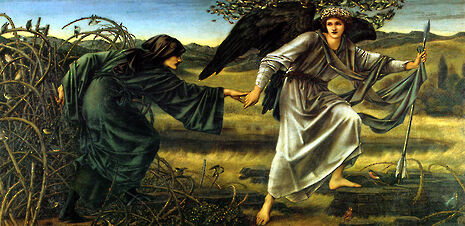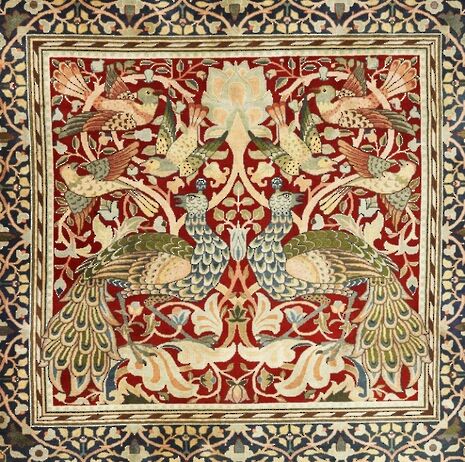Modernising the Victorians
Following the opening of the Tate’s Pre-Raphaelite exhibiton, Anna Souter considers the continuing significance of the famous brotherhood

Until recently, the Pre-Raphaelites have been relegated by modern taste to a murky backwater of 'Victoriana', thought to embody a quaint vision of sentimental escapism propagated by the upper classes. With a few notable exceptions, this backwater is where they have rested since their decline in popularity around the advent of twentieth-century Modernism. In 1935, the Tate was able to purchase Burne-Jones's Love Leading the Pilgrim for a mere £94 10s, testifying to the low regard in which the movement has been held. However, emerging reappraisals of the Pre-Raphaelites lay emphasis on the surprisingly revolutionary nature of the movement, its members and its artistic output.
This is precisely what Tate Britain's autumn blockbuster exhibition takes pains to demonstrate. Pre-Raphaelites: Victorian Avant-Garde attempts, as its title suggests, to rescue these artists from cultural ignominy and to showcase their radical vision within their artistic and social contexts.
It is perhaps no coincidence that the Tate has chosen to launch such a milestone exhibition in a year which has seen a significant emphasis on all things British. The Pre-Raphaelites' musical peers have seen a similar resurgence, as evidenced by the proliferation of British composers such as Elgar and Vaughan Williams at the BBC Proms this summer. This is in many ways a result, both directly and indirectly, of a cultural coup attempting to capitalise on this decade's holy trinity of Britishness (the Royal Wedding, Diamond Jubilee and London Olympics).
But the Pre-Raphaelite movement can strike a resounding chord with a 21stcentury audience, British or otherwise, thanks to its combinations of realism and idealism, high-minded socialism and business acumen, art and craft.
The movement began in 1848 when three young artists somewhat presumptuously named themselves the Pre-Raphaelite Brotherhood: Dante Gabriel Rossetti, William Holman Hunt and John Everett Millais. Attempting to throw off the shackles of the Royal Academy, which claimed a monopoly on artistic taste, the Brotherhood espoused the ideas of the famous art critic John Ruskin, drawing particularly on his respect for all things medieval and on the perceived importance of painting from nature. When they secured the great man himself as patron and champion, their success became assured.
As the exhibition demonstrates, although the Pre-Raphaelite Brotherhood only existed for five years, the founders and other associated artists continued to develop the ideas of the Brotherhood for a further quarter of a century. The movement arguably contributed to the nascent Symbolist, Aesthetic and Arts and Crafts movements.

One of the most central pieces in the exhibition is not a painting by one of these artists, but a piece of furniture designed and made by women. William Morris's bed, taken from his country home at Kelmscott, provides a centrepiece to the room in the exhibition devoted to Pre-Raphaelite design (another vital, often forgotten, legacy).
The hangings and counterpane are designed and created by Morris's daughter, May, pointing to the central role of craft in the Pre-Raphaelite vision and detracting from the popular image of the Brotherhood as a group of white middle-class males intent on portraying women as sexualised objects.
William Morris, a second-generation Pre-Raphaelite and protégé of Rossetti, has often been somewhat marginalised in Pre-Raphaelite scholarship. However, he is a figure who embodies many of their aims and interests, and who arguably speaks most convincingly to our modern age.
Morris was no painter (as his only known easel work, La Belle Iseult, demonstrates), but his proliferation of other talents made up for this failing. Known primarily to his contemporaries as a poet, he was also a committed and brilliant designer, translator, printer, socialist, conservationist, craftsman and businessman.
His abhorrence of mass-manufactured goods combined with his need to make a living led Morris to the rather modern occupation of running a business. Under his guidance, the Pre-Raphaelite interior design firm Morris, Marshall, Faulkner & Co. became a commercial and artistic success, and still flourishes today.
The firm's beautiful and practical hand-made home furnishings embody his mantra of 'art for life'. This aspect of the Pre-Raphaelite ideal perhaps resonates particularly strongly today, in an age which values comfort and informality in the home and which is increasingly aware of its subjection to the trends of mass-manufacturing and marketing.
As an ardent socialist, Morris was painfully aware that his costly labour-intensive designs could only be afforded by a social elite. Yet in bringing artistic design into the home and into public spaces such as the South Kensington Museum, he began to bring art to the domestic sphere of the masses in an unprecedented way.
Morris claimed “I do not want art for a few, any more than I want education for a few or freedom for a few.” His version of the Pre-Raphaelite vision suggests that he was a man of our time, committed to expanding the definition of art to include all areas of craft and design and to bringing art and beauty into every sphere of life.
 Interviews / ‘People just walk away’: the sense of exclusion felt by foundation year students19 April 2024
Interviews / ‘People just walk away’: the sense of exclusion felt by foundation year students19 April 2024 News / Copycat don caught again19 April 2024
News / Copycat don caught again19 April 2024 News / AMES Faculty accused of ‘toxicity’ as dropout and transfer rates remain high 19 April 2024
News / AMES Faculty accused of ‘toxicity’ as dropout and transfer rates remain high 19 April 2024 Theatre / The closest Cambridge comes to a Drama degree 19 April 2024
Theatre / The closest Cambridge comes to a Drama degree 19 April 2024 News / Acting vice-chancellor paid £234,000 for nine month stint19 April 2024
News / Acting vice-chancellor paid £234,000 for nine month stint19 April 2024





